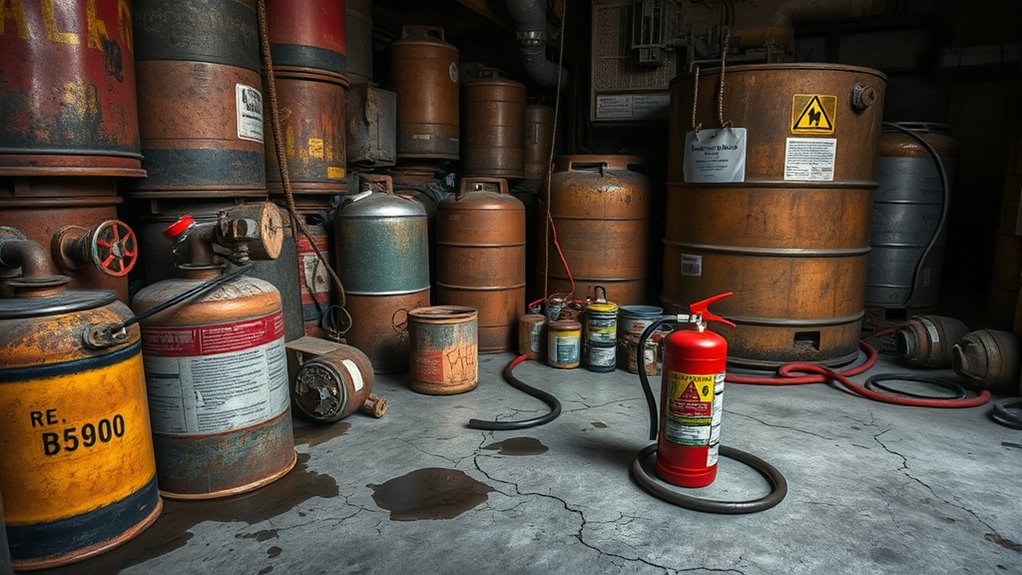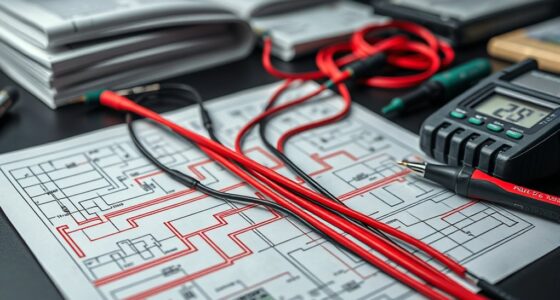To avoid common fuel storage safety mistakes, guarantee proper ventilation and vapor control to prevent vapor buildup. Always use compatible containers and conduct regular inspections to catch leaks or corrosion early. Don’t overfill tanks and make sure all equipment is properly grounded and bonded to prevent static sparks. Follow local regulations, clearly label hazards, and train personnel thoroughly. Skipping these steps can lead to serious hazards—if you want to learn more about safeguarding your storage, keep going.
Key Takeaways
- Regularly inspect and maintain ventilation, vapor control, and grounding systems to prevent vapor buildup and static electricity risks.
- Use compatible containers and perform routine inspections to avoid leaks, corrosion, and fuel contamination.
- Implement proper filling procedures, monitor tank levels, and prevent overfilling to avoid spills and equipment damage.
- Ensure clear labeling, signage, and comprehensive personnel training to promote safety awareness and proper handling.
- Stay updated on regional safety regulations and enforce compliance to mitigate legal issues and safety violations.
Ignoring Proper Ventilation and Vapor Control

Neglecting proper ventilation and vapor control can lead to dangerous buildup of flammable vapors in fuel storage areas. Without adequate airflow, vapors from stored fuel can accumulate quickly, increasing the risk of fire or explosion. Proper ventilation helps dissipate these vapors, reducing their concentration and making the environment safer. Implementing vapor control measures, like using vapor-tight lids and sealed containers, prevents vapors from escaping into the atmosphere where they could ignite. Regularly inspecting ventilation systems ensures they function correctly, especially in enclosed spaces. Failing to maintain proper ventilation and vapor control not only endangers personnel but also puts the entire storage facility at risk. Prioritize these safety measures to keep fuel storage areas secure and compliant with safety standards. Additionally, using diverse designs for storage containers can help optimize space and improve safety protocols.
Using Incompatible Storage Containers

Using incompatible storage containers can cause chemical reactions or leaks that compromise safety. It’s crucial to prioritize container compatibility to prevent hazardous situations. When selecting storage containers, consider material selection carefully; some materials react with fuel, leading to degradation or leaks. For example, metal containers may corrode when in contact with certain fuels, while plastics like high-density polyethylene are generally safe for most gasoline and diesel storage. Always verify that the container material is suitable for the specific fuel type you’re storing. Proper material selection ensures chemical stability and integrity over time, maintaining a safe storage environment. Material compatibility is essential for preventing deterioration and leaks. Never compromise on container compatibility—your safety depends on it.
Neglecting Regular Inspection and Maintenance
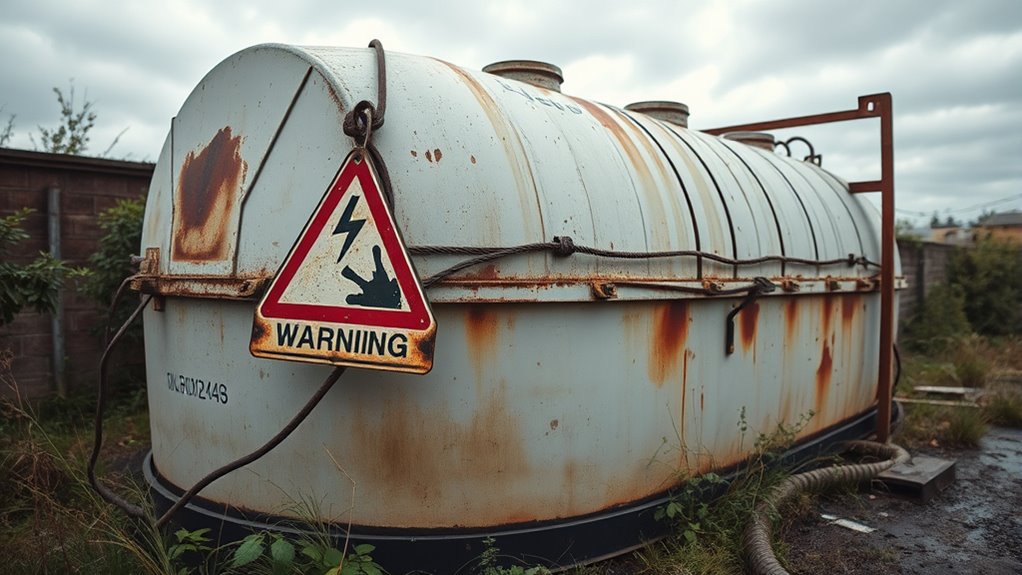
Regular inspection and maintenance are essential to guarantee your fuel storage remains safe over time. Skipping these steps can lead to deteriorating fuel quality, which poses safety risks and reduces fuel efficiency. Regular checks help identify rust, leaks, or corrosion early, preventing costly damage or accidents. Maintaining your storage capacity ensures tanks are neither overfilled nor underutilized, which can compromise safety and fuel integrity. By routinely inspecting vents, gaskets, and fittings, you prevent contamination and leaks that could lead to fire hazards. Proper maintenance also involves cleaning and testing fuel samples. Proper maintenance includes monitoring for signs of contamination, such as sediment or water buildup, which can degrade fuel quality and cause engine issues. Neglecting these duties may result in degraded fuel, compromised storage integrity, and potential safety violations. Staying proactive with inspections keeps your fuel storage safe, efficient, and compliant with regulations.
Overfilling Storage Tanks

Overfilling storage tanks can lead to spills, safety hazards, and equipment damage. It’s essential to follow proper filling procedures and keep a close eye on volume levels during each fill. Monitoring these levels helps prevent accidents and guarantees your storage remains safe and efficient. Proper fuel storage safety practices are key to avoiding these issues.
Risks of Overfilling
When a storage tank is filled beyond its maximum capacity, it can lead to serious safety hazards. Overfilling ignores the natural fuel expansion that occurs with temperature changes, risking spills or leaks. It also stresses the tank’s structure, threatening integrity and safety. Here are the key risks:
- Fuel expansion causes pressure buildup, risking leaks or ruptures.
- Overfilled tanks can overflow, creating fire hazards and environmental contamination.
- Excess fuel puts stress on venting systems, potentially leading to malfunctions.
- Ignoring tank capacity limits increases the chance of accidental spills during filling.
- Proper venting and monitoring are essential to manage fuel expansion effectively and prevent unsafe conditions.
Always respect the tank’s capacity to prevent these dangers. Properly managing fill levels safeguards personnel, the environment, and facility infrastructure.
Proper Filling Procedures
To guarantee safe and efficient fuel transfer, it’s essential to follow proper filling procedures carefully. Always fill tanks gradually, avoiding rapid inflows that can cause spills or tank stress. Ensure the fuel quality is maintained by using clean, properly calibrated equipment to prevent contamination. Keep an eye on storage temperature during filling; overfilling can lead to fuel expansion, risking spills or tank damage. Verify the tank’s capacity beforehand and never exceed recommended levels. Use level indicators or sensors to monitor volume as you fill, stopping promptly when reaching the safe limit. Proper procedures help prevent overfilled tanks, protect fuel integrity, and maintain safety standards. Consistent attention to these steps minimizes risks and guarantees optimal storage conditions. Additionally, understanding local building codes and permits ensures compliance and safety during installation and maintenance.
Monitoring Volume Levels
Monitoring volume levels during fuel transfer is essential to prevent overfilling and guarantee safety. You should implement reliable methods to track the amount of fuel entering the tank. Here are key steps:
- Use calibrated gauges to monitor volume consistently.
- Regularly check sound levels near the tank to detect unusual noises indicating overfill.
- Employ automated shutoff systems that trigger once the desired volume is reached.
- Conduct routine sound level audits to identify potential issues before overfilling occurs.
- Understanding projector contrast ratios can help in assessing whether the monitoring systems are adequately detecting overfill conditions.
Failing to Ground and Bond Equipment

Failing to properly ground and bond equipment can lead to dangerous static buildup and sparks. You need to use correct grounding techniques and high-quality bonding materials to guarantee safety. Preventing static accumulation is essential for avoiding fires and explosions during fuel handling. Additionally, understanding the importance of Indonesian Decor Masks in cultural heritage can remind professionals of the value of tradition and craftsmanship in safety practices.
Proper Grounding Techniques
Proper grounding and bonding are essential safety measures when handling fuel storage equipment, as they prevent static electricity buildup that could ignite flammable vapors. To guarantee effective grounding techniques, follow these steps:
- Connect equipment using a grounding wire to a verified grounding point.
- Use tested and approved bonding methods to establish a continuous electrical path.
- Regularly inspect grounding connections for corrosion or damage.
- Ensure all equipment parts are bonded together before fueling or maintenance.
- Maintaining proper grounding procedures can significantly reduce static electricity risks during fuel handling.
Bonding Material Importance
Using the correct bonding material is essential because it guarantees a reliable electrical connection between fuel storage equipment and grounding systems. Proper bonding importance ensures that static electricity and electrical faults are safely directed to the ground, preventing sparks or explosions. When selecting bonding materials, you must consider their compatibility with the environment and the type of equipment used. Material selection is critical because inferior or inappropriate materials can corrode or fail over time, compromising safety. Using the right bonding wire or clamps made from conductive, corrosion-resistant materials helps maintain a continuous electrical path. Neglecting proper bonding or choosing unsuitable materials can lead to dangerous static buildup, increasing the risk of accidents. Always prioritize high-quality, approved bonding materials to ensure effective grounding and safety. Additionally, understanding cloud service reliance highlights the importance of robust contingency plans in critical systems.
Preventing Static Accumulation
Choosing the right bonding materials helps guarantee a continuous electrical path, but even the best materials won’t prevent static buildup if equipment isn’t properly grounded. Proper grounding is essential for effective charge dissipation. To prevent static accumulation:
- Ensure all tanks, pipes, and containers are correctly grounded to a common grounding point.
- Regularly inspect grounding connections for corrosion or looseness.
- Use bonding wires to connect equipment that might generate static charges.
- Maintain a consistent grounding routine, especially during fueling operations.
Overlooking Spill Prevention Measures

Overlooking spill prevention measures can lead to costly accidents and environmental hazards. You need to prioritize spill containment systems to catch leaks before they escape. Proper spill containment includes secondary barriers like dikes or spill pallets that hold fuel if a primary container fails. Additionally, implementing effective leak detection methods helps you identify issues early, minimizing spill size and damage. Regularly inspect storage tanks and piping for signs of deterioration or leaks. Failing to monitor these components can result in unnoticed spills, risking soil contamination and regulatory fines. By integrating spill containment and leak detection into your safety plan, you protect your environment, reduce cleanup costs, and guarantee compliance. Don’t overlook these measures—they’re essential for a safe, responsible fuel storage operation.
Disregarding Local Regulations and Standards
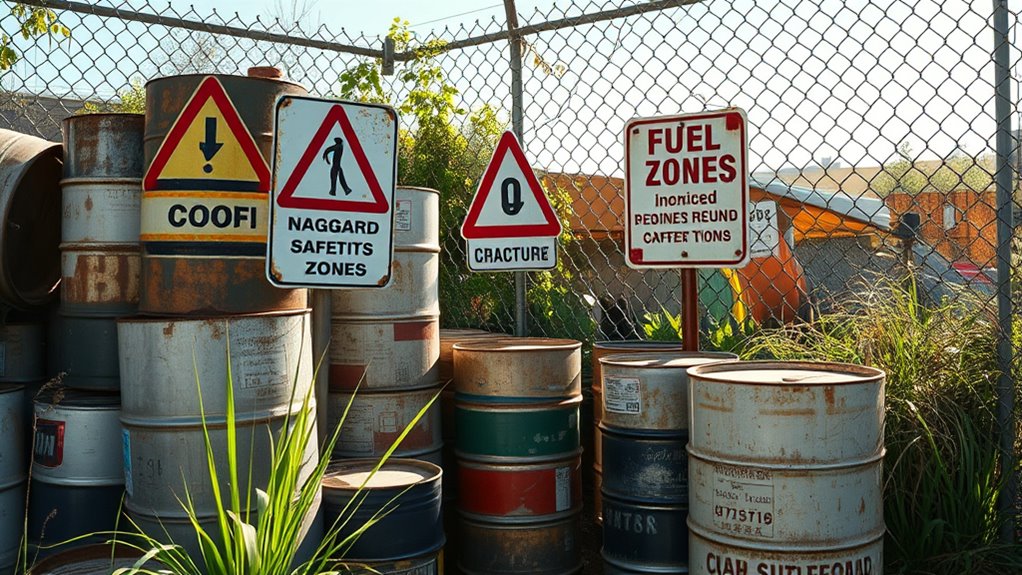
You need to understand the regional regulations that apply to your fuel storage. Staying updated on compliance requirements guarantees you avoid costly violations. Make sure to document any regulatory changes to keep your safety measures current and effective.
Understand Regional Requirements
Have you considered how regional requirements shape fuel storage safety protocols? Ignoring regional compliance can lead to serious safety issues. To stay compliant, you should:
- Research local standards specific to your area
- Consult local authorities or regulatory bodies
- Adapt your safety measures to regional environmental conditions
- Regularly review regional updates to standards
Understanding regional requirements ensures your storage practices meet legal and safety expectations. These standards often differ from one location to another, and neglecting them can result in fines, safety hazards, or environmental damage. By aligning your practices with local standards, you reduce risks and promote safe fuel handling. Always prioritize regional compliance to safeguard your operations and personnel.
Update Compliance Regularly
Staying compliant with regional regulations isn’t a one-time task; it requires ongoing attention to guarantee safety measures stay current. Regularly updating safety protocols ensures your storage practices align with the latest standards, reducing the risk of violations or accidents. Make it a habit to review changes in local rules and incorporate them into your procedures promptly. Enhancing staff training is equally essential; well-informed employees understand the importance of compliance and are better equipped to follow updated guidelines. Keep training programs fresh and relevant, emphasizing new safety measures and regulatory updates. By actively maintaining compliance, you prevent costly violations and foster a safer storage environment. Consistent updates demonstrate your commitment to safety and help avoid overlooked requirements that could compromise your fuel storage operations.
Document Regulatory Changes
Why is it essential to meticulously document regulatory changes across different regions? Keeping track of regulatory updates ensures your fuel storage practices stay compliant and safe. Failure to do so can lead to penalties, safety hazards, and operational setbacks. To effectively document these changes:
- Regularly review local and international standards.
- Update your compliance documentation promptly.
- Track regulatory updates from official sources.
- Train staff on new requirements.
Improper Labeling and Signage
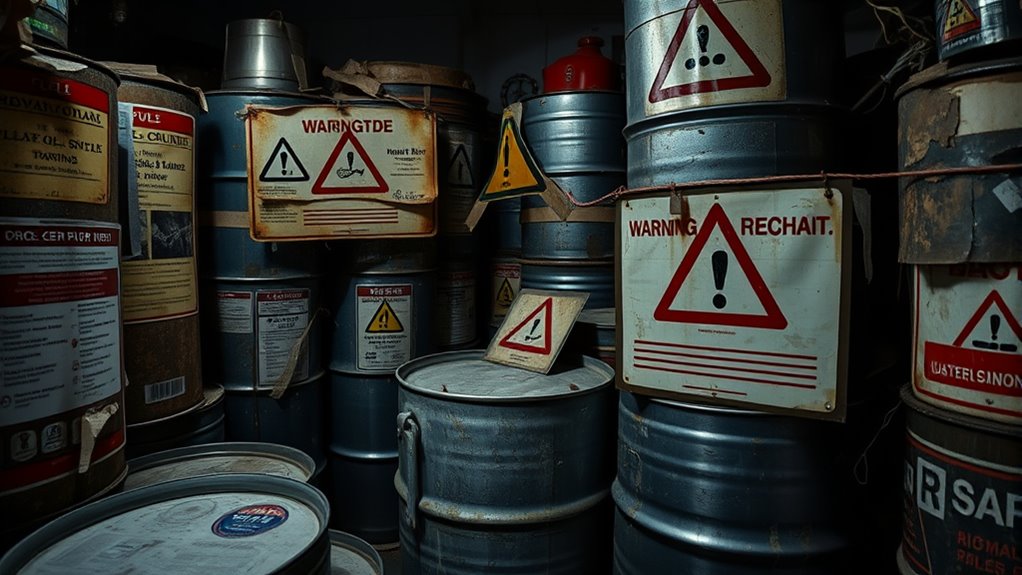
Proper labeling and signage are essential for guaranteeing safe fuel storage, yet many facilities overlook these vital steps. Clear labels improve hazard communication by accurately identifying the type of fuel, storage conditions, and potential risks. When labels don’t meet established labeling standards, workers may misinterpret hazards, leading to accidents or spills. Inadequate signage can cause confusion during emergencies, delaying response efforts. To avoid these issues, ensure all tanks and storage areas are properly labeled with standardized symbols, color codes, and clear instructions. Regularly review and update labels to reflect any changes in stored materials or regulations. Effective hazard communication through proper labeling and signage helps prevent mishandling and ensures everyone understands the risks, safeguarding your facility and personnel.
Skipping Safety Training for Personnel
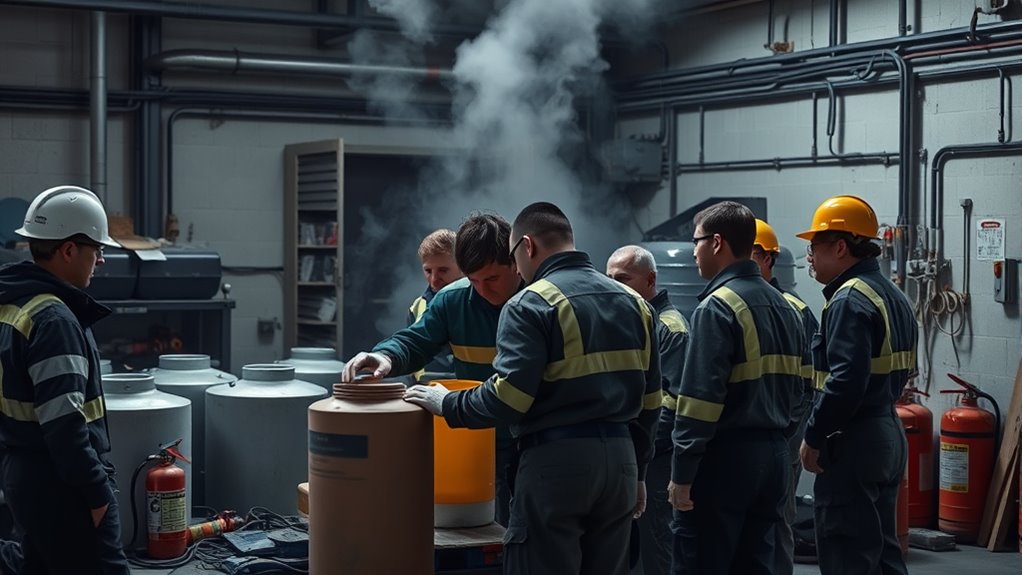
Skipping safety training for personnel markedly increases the risk of accidents and mishandling during fuel storage operations. Without proper training, your team may overlook critical safety procedures, including the use of personal protective equipment and incident reporting protocols.
- You might neglect the importance of PPE, increasing exposure to hazards.
- Your team could mishandle fuel, risking spills or fires.
- The lack of training hampers proper incident reporting, delaying responses.
- It weakens overall safety culture, making accidents more likely.
Delaying Emergency Preparedness and Response Plans
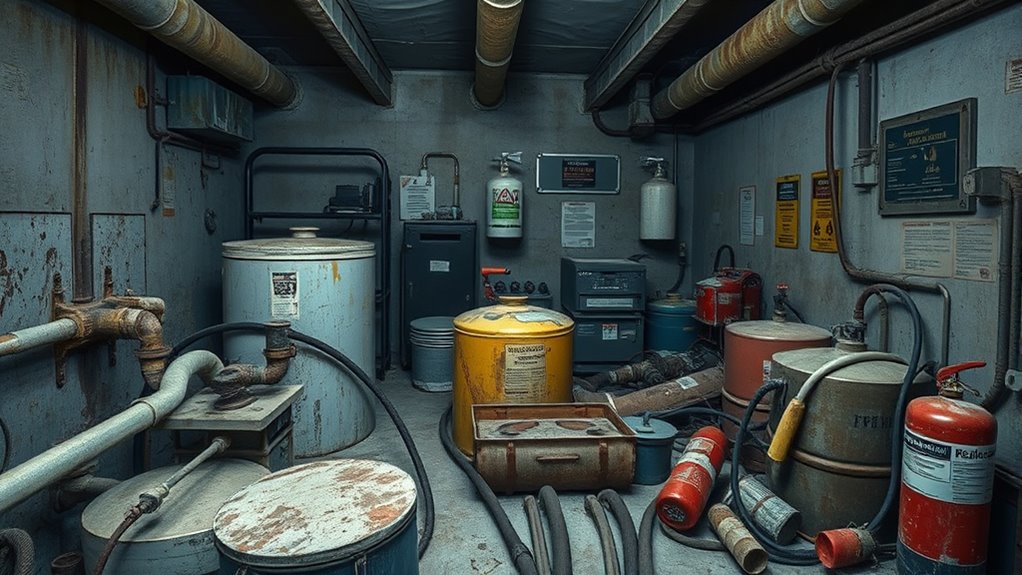
Delaying the development and implementation of emergency preparedness and response plans can leave your fuel storage operations vulnerable when accidents occur. Without a clear plan, you risk confusion and delays during emergencies, worsening the situation. Proper planning guarantees you understand fuel additive compatibility, preventing harmful reactions that could compromise safety. Additionally, having protocols for storage temperature control helps prevent fuel degradation or fires. An effective response plan covers spill containment, fire suppression, and evacuation procedures, minimizing damage and safety risks. Don’t wait until disaster strikes—regularly update and train your team on these plans. Preparing in advance allows you to act swiftly, reducing potential hazards and ensuring compliance with safety regulations. Delay in planning only increases the likelihood of preventable accidents and costly consequences.
Frequently Asked Questions
How Do I Select the Right Fuel Storage Container?
To select the right fuel storage container, you need to take into account fuel container materials that are compatible with your fuel type, such as high-density polyethylene for gasoline. Ensure proper venting to prevent pressure buildup and spills. Look for containers with secure lids and safety features. Always choose containers that meet safety standards and are clearly labeled. This way, you’ll keep your fuel safe while minimizing hazards.
What Are the Signs of Tank Corrosion or Deterioration?
Imagine peering into your tank and noticing jagged rust spots or flaky deposits—these are clear signs of corrosion. During tank inspection, look for discoloration, pitting, or thin walls that suggest deterioration. Corrosion detection is vital because it weakens the tank’s integrity, risking leaks or failures. If you spot these signs, address them promptly to prevent fuel contamination or safety hazards, ensuring your storage remains secure.
How Often Should Safety Drills Be Conducted?
You should conduct safety drills at least twice a year to guarantee preparedness for emergencies. Regular drills strengthen your fire prevention measures and reinforce emergency planning, helping everyone respond swiftly and safely. Schedule drills more frequently if you store large quantities of fuel or if local regulations recommend it. Consistent practice minimizes risks, improves response times, and keeps safety protocols fresh in everyone’s mind, safeguarding your facility from potential hazards.
What Are the Best Practices for Fuel Spill Cleanup?
Did you know that quick response can reduce fuel spill cleanup costs by up to 90%? To effectively clean up a spill, you should first contain it to prevent further spread. Use absorbent materials designed for fuel, and always wear proper protective gear. Focus on fuel spill prevention to minimize environmental impact. Proper disposal of contaminated materials and thorough site decontamination are essential to safeguard the environment and ensure safety.
How Do Weather Conditions Affect Fuel Storage Safety?
Weather impact substantially influences fuel storage safety. Extreme temperatures can cause fuel expansion or contraction, leading to leaks or pressure buildup. Heavy rain or storms may flood storage areas, risking spills or contamination. Climate considerations include monitoring temperature fluctuations and protecting tanks from harsh weather, such as using insulation or weather-resistant covers. By anticipating weather impact, you can implement measures that prevent accidents, ensuring safer fuel storage and reducing environmental risks.
Conclusion
By avoiding these common mistakes, you’ll create a safety net as sturdy as a fortress around your fuel storage. Think of proper precautions as the guiding stars that lead you safely through potential hazards. Don’t let oversight be the cracks in your armor—stay vigilant, follow regulations, and keep your team well-trained. When you prioritize safety, you’re not just preventing accidents—you’re building a shield that keeps everyone and everything protected from harm’s way.
